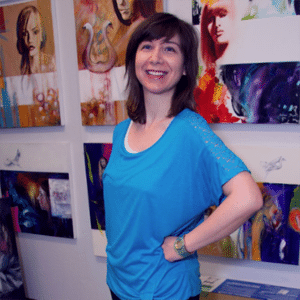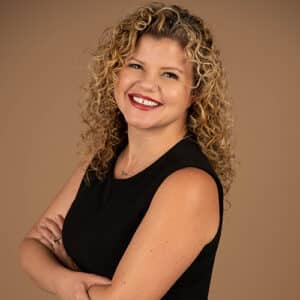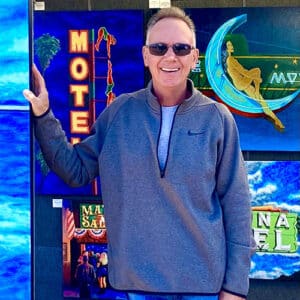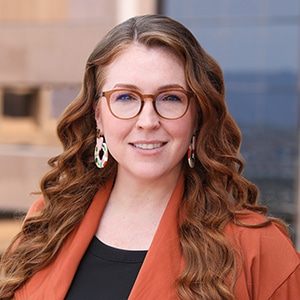
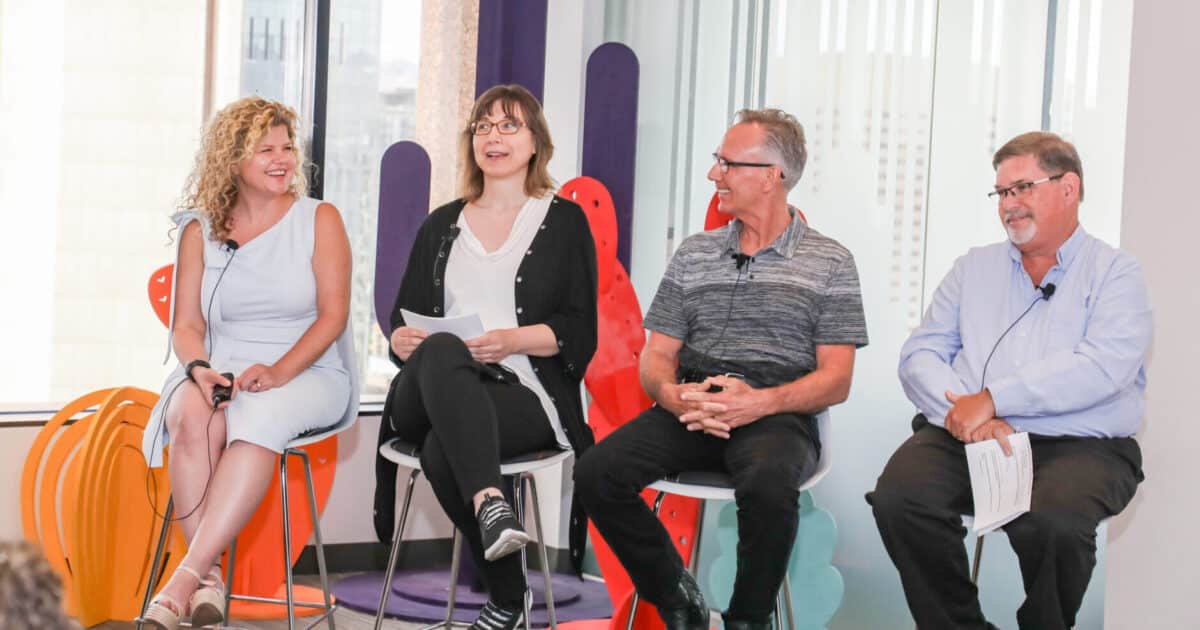
Ambassador Event: Arts & Culture in Greater Phoenix
Published: 06/06/2023
Updated: 06/08/2023
GPEC hosts gallery opening with panel of Greater Phoenix artists and leaders
Arts and culture are integral to the leading economies of the world, promoting cultural exchange and diversity, providing entertainment for citizens and tourists, and contributing directly to the market.
In 2021, arts and culture added $11.6 billion to the Arizona economy, accounting for 2.8% of the gross domestic product (GDP) and employing nearly 85,000 people. GPEC recognizes its impact to developing a region and supports efforts to drive forward arts and culture.
In May, GPEC hosted a gallery opening and panel event surrounding the launch of its newest in-office and online art exhibit called Greater Phoenix Pastimes. The event featured 69 local artists and community partners, offering art, appetizers, and discussion with prominent leaders in Greater Phoenix’s arts and culture scene:
- Edna Dapo, Artist & Department Head of Drawing & Painting, Phoenix Center for the Arts
- Jami Kozemczak, Executive Director, Ballet Arizona
- Patrick McWhortor, CEO, Arizona Citizens for the Arts
- Christopher Roche, Artist & Art Teacher, Mesa Public Schools
- Moderator: Stefanie Carson, Art Director, Greater Phoenix Economic Council
- Opening Remarks: Serena Remy, Vice President of Marketing & Communications, Greater Phoenix Economic Council
“The creative economy extends far beyond direct economic impact. It impacts our daily lives and really threads the fabric of our culture and community. It brings people together and drives innovation across our region,” Remy said.
This marked GPEC’s thirteenth art exhibit since 2018. Over the five years of facilitating these exhibits, more than 550 artists and 980 pieces have been featured. As a nonprofit organization, GPEC does not charge submission fees to artists or take commission from the sale of art pieces.
“Our goal from the beginning was to hold an official gallery opening like this,” Carson said. “Not only to celebrate the outstanding art from so many talented individuals, but to connect them with our amazing community and industry partners with the intention to create more synergies across the region.”
Importance of art education
Arts and culture play a crucial role in fostering creativity, yet many children do not have access to art education outside of school. Roche, who primarily teaches fourth- to sixth-grade students, emphasized how art classes provide outlets for self-expression and engage different parts of students’ minds.
“I’ll have a student who maybe they struggle in the classroom and a lot of the academic subjects, and art might be that one thing they can grab onto and they can see that all of the sudden they’re flourishing,” Roche said.
Unfortunately, arts education often diminishes after students age out of early education classes. The Phoenix Center for the Arts aims to address this gap by offering affordable classes suitable for all ages and skill levels. Learners can explore various topics including a variety of musical instruments, photography, ceramics, painting and drawing. The center also hosts festivals, community events and art outreach initiatives.
“What makes us human? To me, it’s creativity itself,” Dapo said.
Building a region through the arts
Organizations dedicated to promoting arts and culture in Greater Phoenix have seen dividends to their efforts over the last decade.
Arizona Citizens for the Arts, a grassroots entity advocating for public investment and community support for artists, successfully secured a $5 million appropriation for the Arizona Commission on the Arts in both of the last two annual state budgets — a record investment from the state. The arts sector now boasts twice as many jobs as in 2012.
Ballet Arizona exemplifies the power of partnerships among organizations. The organization is collaborating on projects with the Phoenix Symphony and Desert Botanical Garden, finding opportunities to engage with the business community. For instance, Snell & Wilmer and Northern Trust hosted an event at Ballet Arizona, attracting an audience composed 90% of first-timers. Goodmans Interior Structures has partnered with the group for a Tiktok challenge and hosted their company appreciation picnic at Ballet Arizona.
While Greater Phoenix’s arts and culture scene still has room to grow, progress has been made in developing the industry.
“This Phoenix community is a burgeoning metropolis and it is poised to catapult into the future,” Kozemczak said. “Ten years ago, people would say, ‘It’s a cultural backwater, cowboys in the desert’ … but actually, we know that not to be true, and that’s a testament to the people that are willing to make the investment and the commitment to growing art in our community.”
How to support arts and culture
Enhancing access to art programing leads to increased participation. Affordable costs of entry and transportation contribute to higher attendance rates.
“Art access significantly influences the cultural identity by allowing diverse voices to be expressed and represented. It creates a sense of unity, a sense of dialogue,” Dapo said. “Some ways that we can figure out how to create that art access would be a variety of programming such as free art events but also inclusive art education and equitable distribution of funding.”
Cases like Snell & Wilmer, Northern Trust and Goodmans Interior Structures demonstrate how businesses outside the arts realm can collaborate with these organizations. GPEC invited artists from its previous exhibit, Greater Phoenix is Poppin’, to the organization’s end-of-year party to facilitate connections between artists, community leaders and business professionals.
Direct connections drive progress. McWhorter shared an encounter with a local legislator at a Phoenix Conservatory of Music fundraising event where the legislator noted the impact programming had on the kids’ development and confidence. He recognized that though not everyone in the program will become a musician or artist, the education will help them no matter what they do in life, and asked how the region can do more.
“Arts reflect both who we are and who we want to be. Arts are a creative way for looking at the world in different ways, connecting to people of all types from places that you’ve never heard of,” McWhortor said. “Any movement for social change, for political change, starts with people understanding and learning, and arts are a very powerful way of doing that.”
Read op-ed co-written by McWhortor and GPEC CEO Chris Camacho:
To maximize economic growth, we must invest in Arizona’s creative economy
Meet the Panel
Edna Dapo
Artist & Department Head of Drawing & Painting
Phoenix Center for the Arts
Jami Kozemczak
Executive Director
Ballet Arizona
Patrick McWhortor
CEO
Arizona Citizens for the Arts
Christopher Roche
Artist & Art Teacher
Mesa Public Schools
Stefanie Carson (Moderator)
Art Director
Greater Phoenix Economic Council
Serena Remy (Opening Remarks)
Vice President of Marketing & Communications
Greater Phoenix Economic Council
